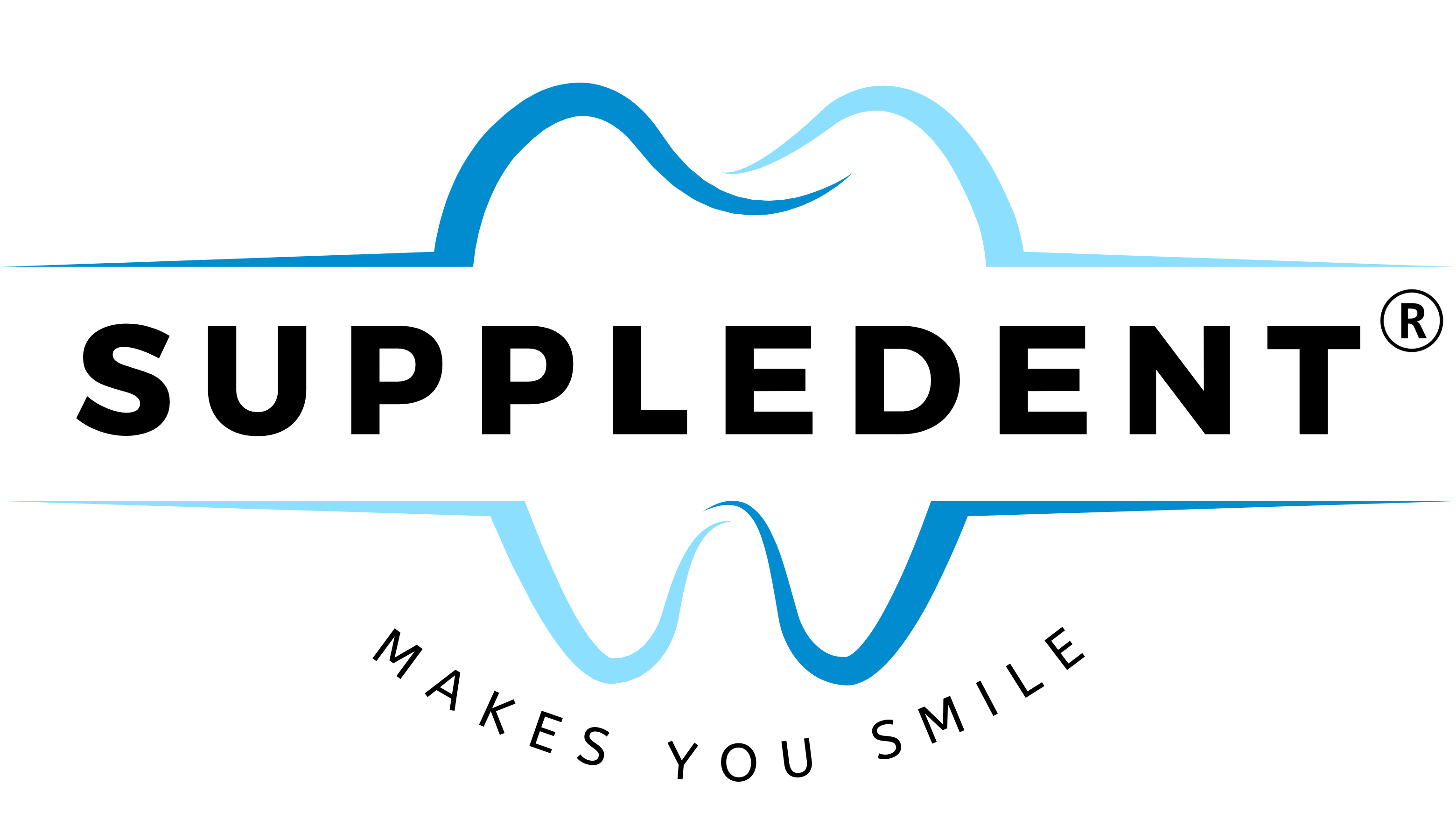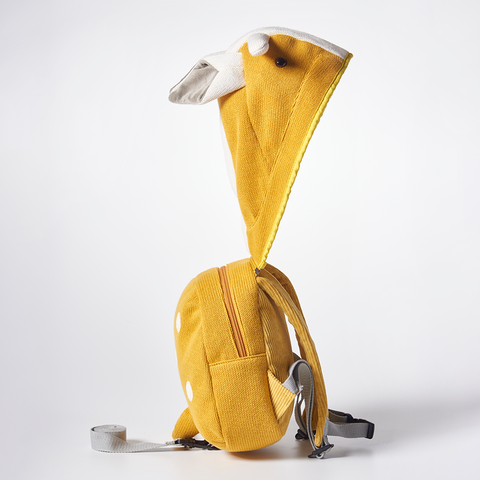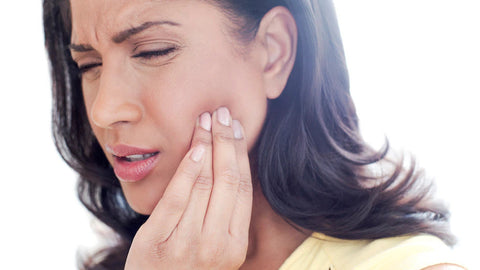Welcome to the Suppledent blog! As a dentist, it's my goal to provide you with sound information and practical tips for optimal oral hygiene. Proper care of your teeth and gums not only contributes to a radiant smile, but also to your overall health.
Basics of dental care: The relationship between plaque and oral health
Daily care of your teeth and gums is crucial for preventing dental diseases such as cavities and periodontitis. An effective routine includes brushing twice a day, using interdental brushes, and eating a balanced diet.
Plaque and cavities: Plaque is a soft, sticky film that continuously forms on your teeth. It consists primarily of bacteria, food debris, and saliva. These bacteria are not only naturally present in the human mouth, but can also become prevalent if oral hygiene is inadequate. They produce acids that attack tooth enamel, which can ultimately lead to cavities. Cavities are the process of destruction of tooth enamel, resulting in holes or cavities in the teeth. Therefore, it is essential to brush your teeth daily to remove plaque.
Plaque, gingivitis, and periodontitis: Not only the teeth, but also the gums suffer from the presence of plaque. If plaque is not removed regularly, it can accumulate along and below the gum line and lead to gum inflammation, known as gingivitis. Symptoms of gingivitis include red, swollen, and easily bleeding gums. If gingivitis is left untreated, it can progress to periodontitis, a more severe form of gum disease. Periodontitis affects not only the gums but also the underlying bone that supports the teeth. This can lead to loose teeth and, in the worst cases, tooth loss. One positive aspect of gingivitis is that, with optimal dental cleaning, it often clears up within a few days.
Prevention through proper care: Regular removal of plaque through brushing, the use of interdental cleaning aids and, if necessary, additional oral hygiene products is essential to avoid these complications.
The importance of interdental cleaning in dental practice
At my clinic, we offer a wide range of dental treatments, including bone and gum grafting and complex restoration of chewing function through interdisciplinary collaboration between various disciplines. However, the majority of our work, in over 80% of our patients, involves the treatment of carious lesions. From our daily practice, we know that 9 out of 10 cases of caries occur between the teeth.
To treat this type of caries, we almost always have to remove healthy tooth substance from the chewing surface, as it's otherwise impossible to reach the carious area. What's particularly insidious is that caries between the teeth often becomes visible very late. By the time our patients feel pain, the caries is usually already close to the dental nerve, and it's only a small step to root canal treatment or, in the worst case, tooth extraction.
Prevention of caries by cleaning the spaces between teeth
To avoid these problems, regular interdental cleaning is essential. However, we recognize that establishing a daily interdental cleaning routine isn't easy. Many of our patients intensively clean their interdental spaces shortly before and after dental visits, but often let this practice subside after a few days or weeks. Another problem is that cleaning is often approached in an overly complicated manner, which further reduces motivation.
It's crucial that interdental cleaning be done without too much hassle or time. The tool chosen should be easy to use and not unnecessarily complicate the cleaning process. From a dental perspective, interdental brushes are the most recommended tool, followed by wooden toothpicks, rubberized toothpicks, dental floss, and air floss.
Recommendations for an effective routine
It's important to clean between your teeth regularly. Flossing is always better than no flossing at all. My recommendation for an effective daily routine is to clean between your teeth once a day in the evening before brushing your teeth with a suitable flosser for a maximum of one minute. Then, rinse your mouth and brush your teeth for about two minutes.
Recommendations for choosing the right dental care products
As a dentist, I would like to recommend the most effective products for maintaining optimal oral hygiene. Here are my suggestions for an efficient and comprehensive dental care routine:
Toothbrushes – electric and manual: For daily brushing, I recommend toothbrushes with soft bristles, whether electric or manual. Soft bristles are gentle on the gums and prevent gum recession and enamel damage that can be caused by bristles that are too hard. Electric toothbrushes also offer the advantage of more thorough plaque removal through oscillating or rotating movements.
Interdental tools: Cleaning between your teeth is crucial for preventing cavities and gum disease. I recommend using interdental brushes, dental floss, or water flossers, depending on the size of your spaces and your personal preference. These tools help effectively remove plaque and food debris that accumulate between your teeth.
Dietary supplements: If your nutrient intake is suboptimal, I recommend specially formulated supplements that support dental and gum health. These may contain important vitamins and minerals such as vitamin D, calcium, and phosphorus, which are essential for maintaining strong teeth and healthy gums.
Toothpaste – with or without fluoride: The choice of toothpaste depends on your specific needs. Toothpastes with fluoride are excellent for protecting against cavities, while fluoride-free options may be suitable for people who are sensitive to fluoride or who wish to avoid it for health reasons.
Tongue scraper: A tongue scraper is a useful tool for removing bacterial plaque from the tongue that can cause bad breath. Regularly using a tongue scraper as part of your oral hygiene routine can help keep your breath fresh and reduce the buildup of bacteria.
Personalized consultation: At Suppledent, we understand that everyone has unique oral health needs. That's why we offer personalized consultations to help you find the right tools to keep your teeth and gums healthy.
Tooth cleaning techniques: Different brushing methods for effective oral hygiene
Taking care of your teeth through regular and proper brushing is one of the most basic and important steps for maintaining oral health. A clean, healthy mouth is not only crucial for a radiant smile, but also plays a pivotal role in overall health. Dental diseases such as cavities and periodontal disease can not only lead to tooth loss but are also linked to other serious health problems, including cardiovascular disease, diabetes, and even certain forms of cancer.
However, brushing your teeth isn't simply a routine; it's an art that requires the right technique to be effective. The technique you choose can have a huge impact on how well you remove plaque and food debris from your teeth and along the gum line. Plaque is a sticky layer of bacteria that constantly builds up on your teeth. If not removed regularly, it can harden and turn into tartar, which in turn leads to gum inflammation and other dental problems.
While most people are aware of their teeth, many are unaware of the optimal brushing techniques that provide the best protection against disease. In this section, we'll introduce several tried-and-true brushing techniques recommended by dental professionals. These methods vary in execution and are suitable for different needs, from general cleaning to targeted care for braces or sensitive gums. By choosing and applying the right technique, you can ensure your oral hygiene practice is as effective as possible and your teeth and gums stay healthy.
Manual toothbrush:
Bass method:
- Description: Technique focusing on cleaning the gum line.
- Application: Small circular movements, holding the brush head at a 45-degree angle to the gums.
- Target group: Recommended for all age groups, especially effective for the prevention of gum disease.
Stillman method:
- Description: Modification of the Bass technique, ideal for massaging and stimulating the gums.
- Application: Brush at a 45-degree angle to the gums, using light vibrating movements.
- Target group: Suitable for people with receding gums or gingivitis.
Charters method:
- Description: Focuses on cleaning tooth surfaces and interdental spaces.
- Application: Brush head at a 45 degree angle to the tooth, short lateral movements.
- Target group: Especially helpful for wearers of braces and bridges.
Fones technology:
- Description: Simple technique, ideal for children and beginners.
- Application: Bite your teeth together and move the toothbrush in large circular movements over all teeth.
- Target group: Children and people who have difficulties with other techniques.
Scrub technique:
- Description: Simple horizontal or scrubbing movements.
- Application: Straight strokes along the row of teeth, both on the outside and inside of the teeth.
- Target group: Less recommended due to possible damage to gums and tooth enamel, but is often used intuitively.
Modified scrub technique:
- Description: A combination of circular and horizontal movements, less aggressive than the pure scrub technique.
- Application: Alternate between gentle circular and light horizontal movements.
- Target group: An alternative for those who are used to the scrub technique but want to clean more gently.
Electric toothbrush:
Basic technique with an electric toothbrush:
- Description: This technique uses the oscillating or rotating movements of the electric brush to effectively remove plaque.
- Application: Hold the brush lightly against your teeth and gums at an angle of approximately 45 degrees. Slowly move the brush from tooth to tooth, allowing the brush to work on each tooth and its surrounding area for a few seconds.
- Target group: Suitable for anyone who wants to benefit from the improved cleaning effect of an electric toothbrush.
Intensive cleaning technology:
- Description: A method for deeper cleaning, especially suitable for people at higher risk of gum disease.
- Application: Focus especially on the gum line, moving the brush in small sections along the gum line. Use gentle pressure to avoid irritating the gums.
- Target audience: Especially recommended for people with signs of gum disease or those who need a more thorough cleaning.
Technique for sensitive teeth:
- Description: A gentle method specifically tailored to the needs of people with sensitive teeth and gums.
- How to use: If your electric brush has a sensitive mode or brush head, use one. Hold the brush as usual, but reduce the pressure and let the brush do the work.
- Target group: Ideal for people with tooth sensitivity or those prone to bleeding gums.
Cleaning hard-to-reach areas:
- Description: A technique that helps to thoroughly clean the back molars and other hard-to-reach areas.
- Directions: Tilt the brush head for better access to the back molars and the inner surfaces of the lower and upper teeth. It may be helpful to open your mouth wider to make these areas more accessible.
- Target group: Especially important for people who are prone to plaque accumulation in the back of the mouth.
We've examined various tooth cleaning techniques, each offering its own benefits and specific applications. From the Bass method, which focuses specifically on cleaning along the gum line, to the Fones technique, which is especially child-friendly, to specialized techniques for using electric toothbrushes, each method aims to optimize oral hygiene and promote the health of your teeth and gums.
It's important to understand that choosing the right brushing technique can make a significant difference in the effectiveness of your daily oral care routine. It's equally important to practice these techniques regularly and adapt them to your specific needs as needed. Good oral hygiene isn't just about the right technique, but also about consistency in care.
Furthermore, the variety of techniques presented here underscores the importance of regular dental checkups. Your dentist or dental hygienist can not only check that you're using your brushing technique correctly but also advise you on which method best suits your individual needs. This professional guidance is crucial to ensuring your dental care method is optimal and protecting you from dental problems.
By visiting your dentist regularly and being open to adjustments and improvements in your brushing technique, you are investing in your long-term health and ensuring that your smile remains bright and healthy not only today but also in the future.
Regular dental checkups: The importance of monitoring your oral health
Regular consultations with your dentist play a crucial role in maintaining your long-term oral health. Dental checkups not only serve to detect problems early, but also provide preventative care aimed at preventing more serious conditions.
Professional monitoring: Regular visits to the dentist ensure that your oral health is continuously monitored. Your dentist can detect early signs of conditions such as cavities, gum disease, and other oral conditions long before they cause serious problems. This early diagnosis is crucial for easy and successful treatment.
Professional teeth cleaning: One of the most important preventative measures performed during a dental visit is a professional teeth cleaning. This cleaning removes plaque and tartar, which build up over time and are difficult to remove with conventional at-home brushing techniques. Tartar, the hardened form of plaque, adheres firmly to the tooth surfaces and below the gum line. Without professional removal, tartar can lead to gingivitis and further gum disease.
Benefits of regular visits: In addition to teeth cleaning, your dentist will offer valuable advice on improving your personal dental care routine and can recommend specific products or techniques that best suit your individual situation. Regular dental checkups also allow you to monitor your oral health progress and make adjustments as needed.
Regular dental checkups and care are essential to prevent serious dental disease and maintain a healthy smile. It's recommended to visit a dentist at least twice a year, or more often depending on your specific needs. Such regular visits are an investment in your health that will pay off in the long run.
We've discussed the most important aspects of dental and oral care, from choosing the right dental products and different brushing techniques to the importance of regular dental checkups. By using the recommended techniques and products, you can not only improve the health of your teeth and gums but also enhance your overall well-being. Remember, good oral hygiene is more than just brushing; it's a comprehensive care routine that requires regular checkups and adjustments to your individual needs. By following these practices, you can ensure your smile stays healthy and bright.




